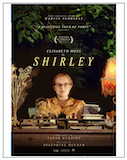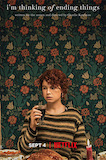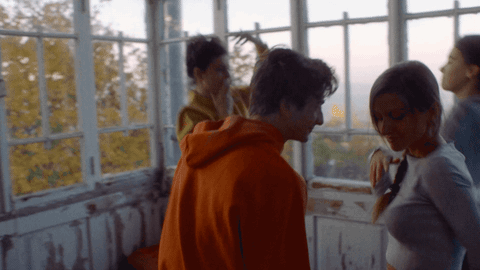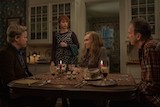Movie | Buried Treasure | Director | Actress | Actor | Supporting Actress| Supporting Actor | Original Screenplay | Adapted Screenplay | Music in a Film | Editing | Cinematography | Production Design | Ensemble Cast | Documentary | Special
Best Movie |
|
  Portrait of a Lady on Fire – “Celine Sciamma’s exquisite 18th century romance between two women, an artist (Noémie Merlant) and her subject (Adèle Haenel) gains so much power from the barest essentials. Rather than pile on stylistic cues to lead the audience in a certain direction, this takes the slow burn route, deploying all of its accoutrements sparingly, letting the connection between its two leads develop organically so that when it reaches a crescendo in the astonishing feast scene midway through, one can’t help but be fully engaged in their fate. And, as that actual fate becomes apparent, it’s near-impossible not to feel and absorb the mad rush of emotions practically emanating from the screen, culminating in a simple but profound, powerful final shot.” –ck Portrait of a Lady on Fire – “Celine Sciamma’s exquisite 18th century romance between two women, an artist (Noémie Merlant) and her subject (Adèle Haenel) gains so much power from the barest essentials. Rather than pile on stylistic cues to lead the audience in a certain direction, this takes the slow burn route, deploying all of its accoutrements sparingly, letting the connection between its two leads develop organically so that when it reaches a crescendo in the astonishing feast scene midway through, one can’t help but be fully engaged in their fate. And, as that actual fate becomes apparent, it’s near-impossible not to feel and absorb the mad rush of emotions practically emanating from the screen, culminating in a simple but profound, powerful final shot.” –ck |
|
 And Then We Danced – “A coming-of-age story about a young man growing up in a traditional, conservative town in Georgia (the country). Owes a lot to CALL ME BY YOUR NAME, but there are far worse films to pay tribute to; actually, it transcends homage in its Georgian dance sequences and in particular, that rapturous finale.” — ck, mrc And Then We Danced – “A coming-of-age story about a young man growing up in a traditional, conservative town in Georgia (the country). Owes a lot to CALL ME BY YOUR NAME, but there are far worse films to pay tribute to; actually, it transcends homage in its Georgian dance sequences and in particular, that rapturous finale.” — ck, mrc |
|
 First Cow – “Helmer Kelly Reichardt (WENDY AND LUCY, OLD JOY) gives us another languid story with a deep sense of character. The gentle, gestating narrative requires patience, but it also rewards those who become invested in the fate of a cook and a Chinese immigrant as they become unlikely friends and form an impromptu business partnership. What they build is forever precariously hanging by a string due to the titular animal that makes their potential fortune possible. By applying such high stakes to such richly detailed ‘slow’ cinema, FIRST COW ends up Reichardt’s most fully realized effort in years. Wonderful details that allowed the viewer to appreciate the diversity of cultures, dress, shelters, and personalities of this trapping/gold-digging era of our history.” — djy, ck First Cow – “Helmer Kelly Reichardt (WENDY AND LUCY, OLD JOY) gives us another languid story with a deep sense of character. The gentle, gestating narrative requires patience, but it also rewards those who become invested in the fate of a cook and a Chinese immigrant as they become unlikely friends and form an impromptu business partnership. What they build is forever precariously hanging by a string due to the titular animal that makes their potential fortune possible. By applying such high stakes to such richly detailed ‘slow’ cinema, FIRST COW ends up Reichardt’s most fully realized effort in years. Wonderful details that allowed the viewer to appreciate the diversity of cultures, dress, shelters, and personalities of this trapping/gold-digging era of our history.” — djy, ck |
|
 Never Rarely Sometimes Always – “This riveting films follows Autumn’s difficult journey to New York City to terminate her pregnancy with almost documentary-style precision. In fact, for the first half of the film, it felt a little like a really well-acted, well-shot, after-school cautionary tale about teen pregnancy. Then out of nowhere comes the moment that birthed the film’s title, and with it your heart breaks for young Autumn as the magnitude of her life comes emotionally crashing to the fore.” — mrc Never Rarely Sometimes Always – “This riveting films follows Autumn’s difficult journey to New York City to terminate her pregnancy with almost documentary-style precision. In fact, for the first half of the film, it felt a little like a really well-acted, well-shot, after-school cautionary tale about teen pregnancy. Then out of nowhere comes the moment that birthed the film’s title, and with it your heart breaks for young Autumn as the magnitude of her life comes emotionally crashing to the fore.” — mrc |
|
 Sound of Metal – “Raw, gut-pinch of a film, anchored by riveting, intense performances, about a recovering addict and drummer in a thrash punk band who slowly realizes that he is losing his hearing. His journey to find his new place in life is long and arduous, and filled with struggles of all sorts. Director Marder doesn’t provide any easy solutions, but there is hope and promise in his tale.” — mrc Sound of Metal – “Raw, gut-pinch of a film, anchored by riveting, intense performances, about a recovering addict and drummer in a thrash punk band who slowly realizes that he is losing his hearing. His journey to find his new place in life is long and arduous, and filled with struggles of all sorts. Director Marder doesn’t provide any easy solutions, but there is hope and promise in his tale.” — mrc |
|
Buried Treasure |
|
| IT’S A TIE! | |
  Ghost Tropic – “Khadija, a Maghrebi woman living in Brussels, works the evening shift as a cleaning woman for a large office building. One night as her shift ends, she boards the last bus to travel home, but she falls asleep, and ends up on the opposite end of the city from her home. GHOST TROPIC follows Khadija’s long walk home through the city which takes on a very different characteristic in the wee hours of the night, when encounters are few, and shadows seem magical. With sparse, yet innovative direction, and a beautiful performance from Saadia Bentaïeb, take your time and sink into the languorous beauty of GHOST TROPIC.” –mrc Ghost Tropic – “Khadija, a Maghrebi woman living in Brussels, works the evening shift as a cleaning woman for a large office building. One night as her shift ends, she boards the last bus to travel home, but she falls asleep, and ends up on the opposite end of the city from her home. GHOST TROPIC follows Khadija’s long walk home through the city which takes on a very different characteristic in the wee hours of the night, when encounters are few, and shadows seem magical. With sparse, yet innovative direction, and a beautiful performance from Saadia Bentaïeb, take your time and sink into the languorous beauty of GHOST TROPIC.” –mrc |
|
  Light from Light – “Simple, serene film that could have been a haunted house/ghost story, but turns out to be a transcendent, emotional story about the memories and desires that haunt us, and how we need to connect with others for help. The beautifully restrained, and grounded performances, along with the down-to-earth, yet somehow simultaneously otherworldly cinematography turn this simply presented tale into something truly magical.” –mrc Light from Light – “Simple, serene film that could have been a haunted house/ghost story, but turns out to be a transcendent, emotional story about the memories and desires that haunt us, and how we need to connect with others for help. The beautifully restrained, and grounded performances, along with the down-to-earth, yet somehow simultaneously otherworldly cinematography turn this simply presented tale into something truly magical.” –mrc |
|
 Cat in the Wall – “A look at immigrant life in a gentrifying area of London, with Brexit hanging over everything. A Bulgarian woman, her brother (both well educated) and her son are eking out a life in a former council flat in Peckham. She’s managed to purchase the apartment (so she gets stuck with big bills when repairs are required, even if she doesn’t see the need), and they’re surrounded by neighbors who are on the dole, but blame the immigrants for all the problems in the area.” —bg Cat in the Wall – “A look at immigrant life in a gentrifying area of London, with Brexit hanging over everything. A Bulgarian woman, her brother (both well educated) and her son are eking out a life in a former council flat in Peckham. She’s managed to purchase the apartment (so she gets stuck with big bills when repairs are required, even if she doesn’t see the need), and they’re surrounded by neighbors who are on the dole, but blame the immigrants for all the problems in the area.” —bg |
|
 Marona’s Fantastic Tale – “An animated tale from Romanian director Anca Damian from a screenplay written by her son. The titular character is a dog, who after being hit by a car, reminisces about her several owners. The film emphasizes themes of empathy and acceptance, presented from the perspective of a dog who can love without limits. The story is told in three main segments, created by different animators with distinct visual styles. Marona (in black-and-white with an appropriately heart-shaped nose) is the visual constant, while the owners and their environments vary in their hyper colorful and often surreal presentations. The film nicely balances simple human themes of emotional connection with elaborate multi-layered and always stimulating visuals. A feast for the eyes as well as the heart.” –tp & pe Marona’s Fantastic Tale – “An animated tale from Romanian director Anca Damian from a screenplay written by her son. The titular character is a dog, who after being hit by a car, reminisces about her several owners. The film emphasizes themes of empathy and acceptance, presented from the perspective of a dog who can love without limits. The story is told in three main segments, created by different animators with distinct visual styles. Marona (in black-and-white with an appropriately heart-shaped nose) is the visual constant, while the owners and their environments vary in their hyper colorful and often surreal presentations. The film nicely balances simple human themes of emotional connection with elaborate multi-layered and always stimulating visuals. A feast for the eyes as well as the heart.” –tp & pe |
|
 Song Without a Name – “This film from Peru centers on an indigenous Andean woman whose baby is stolen at birth via an underground trafficking ring. The story is based on real events, and is powerfully told in this beautifully moving film. It’s visually stunning, a triumph in terms of visual design, with scenes that are truly awe inspiring. Other very difficult scenes were shot so well it seemed effortless, but, if you look closely, you shall see so much attention to detail. Melina León’s patient directorial style enhances both the tragedy and the reality of the film. Truly a must see.” –bc, mrc Song Without a Name – “This film from Peru centers on an indigenous Andean woman whose baby is stolen at birth via an underground trafficking ring. The story is based on real events, and is powerfully told in this beautifully moving film. It’s visually stunning, a triumph in terms of visual design, with scenes that are truly awe inspiring. Other very difficult scenes were shot so well it seemed effortless, but, if you look closely, you shall see so much attention to detail. Melina León’s patient directorial style enhances both the tragedy and the reality of the film. Truly a must see.” –bc, mrc |
|
 The Whistlers – This piece from Romanian director, Corneliu Porumboiu (12:08 EAST OF BUCHAREST), is billed as a heist movie, but, in its gritty meditation on corruption, bears little resemblance to its glossy Hollywood counterparts. Cristi is a Romanian cop, working the case of jailed gangster, Zsolt , but also working with Zsolt’s gangster associates to break him out of jail. With shifting allegiances and ever-present surveillance, the central conceit of the film follows Cristi to La Gomera in the Canary Islands to learn the gangster’s coded means of communicating by whistles (thus, the movie’s title), known as El Silbo. A bit of international culture with your complex heist film!” –jp The Whistlers – This piece from Romanian director, Corneliu Porumboiu (12:08 EAST OF BUCHAREST), is billed as a heist movie, but, in its gritty meditation on corruption, bears little resemblance to its glossy Hollywood counterparts. Cristi is a Romanian cop, working the case of jailed gangster, Zsolt , but also working with Zsolt’s gangster associates to break him out of jail. With shifting allegiances and ever-present surveillance, the central conceit of the film follows Cristi to La Gomera in the Canary Islands to learn the gangster’s coded means of communicating by whistles (thus, the movie’s title), known as El Silbo. A bit of international culture with your complex heist film!” –jp |
|
Best Director |
|
  Eliza Hittman for Never Rarely Sometimes Always – “For her third film (and second Chlotrudis nomination), Hittman relied heavily on research she did at abortion clinics, especially concerning minors who travel from other states. This tense, minimalist work provides little relief from a harrowing series of events. But Hittman envisioned it as a character study above all, and pursued a non-actor to play the lead Autumn, a taciturn pregnant teen. It’s Autumn’s face that the camera tenderly focuses on, often in cramped spaces, bringing the viewer into her perspective. What could have been a documentary or an after-school special becomes a character study that takes us deep into an emotional journey.” –djy Eliza Hittman for Never Rarely Sometimes Always – “For her third film (and second Chlotrudis nomination), Hittman relied heavily on research she did at abortion clinics, especially concerning minors who travel from other states. This tense, minimalist work provides little relief from a harrowing series of events. But Hittman envisioned it as a character study above all, and pursued a non-actor to play the lead Autumn, a taciturn pregnant teen. It’s Autumn’s face that the camera tenderly focuses on, often in cramped spaces, bringing the viewer into her perspective. What could have been a documentary or an after-school special becomes a character study that takes us deep into an emotional journey.” –djy |
|
|
|
|
 Darius Marder for Sound of Metal – “While Sound of Metal has a seemingly clear-cut premise (a drummer goes deaf), director Darius Marder expands and transforms it into a far-reaching but compellingly interior study of losing control and the lengths we’ll go in order to retain it. Guiding two standout performances (Riz Ahmed and Paul Raci) while also taking his viewers on an immersive journey questioning the competing notions of want versus need, this is an astonishing feature debut for Marder.” –ck Darius Marder for Sound of Metal – “While Sound of Metal has a seemingly clear-cut premise (a drummer goes deaf), director Darius Marder expands and transforms it into a far-reaching but compellingly interior study of losing control and the lengths we’ll go in order to retain it. Guiding two standout performances (Riz Ahmed and Paul Raci) while also taking his viewers on an immersive journey questioning the competing notions of want versus need, this is an astonishing feature debut for Marder.” –ck |
|
 Kelly Reichardt for First Cow – “Reichardt’s research into the Pacific Northwest in the 1820s brings us a decidedly global version of that place and time: here are Russian, Chinese, Jew, Hawaiian, English, Chinook. Her actors are encouraged to develop their characters simply by putting on the clothes, taking account of their possessions, and doing their daily chores. Working with longtime collaborators (producer, cinematographer, writer), the director creates a tender Western, distilling themes of capitalism and empire.” –djy Kelly Reichardt for First Cow – “Reichardt’s research into the Pacific Northwest in the 1820s brings us a decidedly global version of that place and time: here are Russian, Chinese, Jew, Hawaiian, English, Chinook. Her actors are encouraged to develop their characters simply by putting on the clothes, taking account of their possessions, and doing their daily chores. Working with longtime collaborators (producer, cinematographer, writer), the director creates a tender Western, distilling themes of capitalism and empire.” –djy |
|
 Céline Sciamma for Portrait of a Lady on Fire – “Sciamma opens her film by playing with the conventions of a period piece. Then in the very slow burn of a queer love story, she makes us see afresh what falling in love is like, intellectually as much as physically. Through shots that emphasize secretive or open gazes, she challenges the reductive idea of a muse and questions who is looking at who—portrait artist, subject, film director?” –djy Céline Sciamma for Portrait of a Lady on Fire – “Sciamma opens her film by playing with the conventions of a period piece. Then in the very slow burn of a queer love story, she makes us see afresh what falling in love is like, intellectually as much as physically. Through shots that emphasize secretive or open gazes, she challenges the reductive idea of a muse and questions who is looking at who—portrait artist, subject, film director?” –djy |
|
Best Actress
|
|
  Sidney Flanagan for the role of Autumn in Never Rarely Sometimes Always – “NEVER RARELY SOMETIMES ALWAYS could have been a maudlin film about teenager dealing with an unwanted pregnancy. But it’s not – thanks to the mesmerizing performance of the lead actress, Sidney Flanigan. It’s hard to believe that this is her debut role, but it is. Her ability to keep her inner most feelings hidden until she has to let them go, speaks to her restrained performance. We get to know her not through her words, but rather her revealing eyes and emotional facial expressions. Count on seeing Sidney Flanigan again.” –vo Sidney Flanagan for the role of Autumn in Never Rarely Sometimes Always – “NEVER RARELY SOMETIMES ALWAYS could have been a maudlin film about teenager dealing with an unwanted pregnancy. But it’s not – thanks to the mesmerizing performance of the lead actress, Sidney Flanigan. It’s hard to believe that this is her debut role, but it is. Her ability to keep her inner most feelings hidden until she has to let them go, speaks to her restrained performance. We get to know her not through her words, but rather her revealing eyes and emotional facial expressions. Count on seeing Sidney Flanigan again.” –vo |
|
 Tsai Chin for the role of Grandma in Lucky Grandma – There would be no LUCKY GRANDMA without Tsai Chin. The internationally celebrated actor, director, teacher and author, best known in America for her film role as Auntie Lindo in THE JOY LUCK CLUB, embodies the indomitable, irascible, grouchy ‘Grandma’ in Sasie Sealy’s action comedy so perfectly, it’s hard to imagine her as the Bond Girl in YOU ONLY LIVE TWICE and CASINO ROYALE.She is off-putting and confident on the surface, but inevitably, there is a reason for it internally, and when her past hurts are revealed, there is no cheapening or excusing her behavior, but there is earned sympathy. Honestly, Chin makes ‘Grandma’ so much fun, we could watch her in the ‘Lucky Grandma’ TV series.” –mrc Tsai Chin for the role of Grandma in Lucky Grandma – There would be no LUCKY GRANDMA without Tsai Chin. The internationally celebrated actor, director, teacher and author, best known in America for her film role as Auntie Lindo in THE JOY LUCK CLUB, embodies the indomitable, irascible, grouchy ‘Grandma’ in Sasie Sealy’s action comedy so perfectly, it’s hard to imagine her as the Bond Girl in YOU ONLY LIVE TWICE and CASINO ROYALE.She is off-putting and confident on the surface, but inevitably, there is a reason for it internally, and when her past hurts are revealed, there is no cheapening or excusing her behavior, but there is earned sympathy. Honestly, Chin makes ‘Grandma’ so much fun, we could watch her in the ‘Lucky Grandma’ TV series.” –mrc |
|
 Adele Haenel for the role of Héloïse in Portrait of a Lady on Fire – “Happily, PORTRAIT was written with Haenel (DEERSKIN, WATER LILIES) in mind–and not for the painter’s role, as everyone expected. She is the aristocratic beauty who refuses to be painted, enigmatic and stubborn, dissatisfied with the hand that life has dealt her. Haenel is an inventive actress, using her face like a mask until there is a shift an hour into the film and she…smiles.” –djy Adele Haenel for the role of Héloïse in Portrait of a Lady on Fire – “Happily, PORTRAIT was written with Haenel (DEERSKIN, WATER LILIES) in mind–and not for the painter’s role, as everyone expected. She is the aristocratic beauty who refuses to be painted, enigmatic and stubborn, dissatisfied with the hand that life has dealt her. Haenel is an inventive actress, using her face like a mask until there is a shift an hour into the film and she…smiles.” –djy |
|
 Aubrey Plaza for the role of Allison in Black Bear – “Two-time Chlotrudis nominee Aubrey Plaza is intoxicatingly luminous in her role as Allison in Lawrence Michael Levine’s BLACK BEAR. From voicing animated characters in series such as ‘The Legend of Korra’ to carrying out maniacal roles such as Lenny in FX’s ‘Legion,’ and arguably known for her most notable role as April on NBC’s ‘Parks and Recreation,’ Plaza has more than proven her ability to portray an eclectic array of characters. In BLACK BEAR, we see Plaza flex her ability to be more than one character to the audience, in a similar way that we see her brilliance in ‘Legion.’ In a two-chapter movie, the audience gets two configurations of a love triangle between a filmmaker and a couple, two ways (including Christopher Abbot and Sarah Gadon). As you can imagine, jealousy, manipulation, and anger abound, and a performance from Plaza that begins with her being the manipulator, ending with her being manipulated leaves you what would have transpired had there been a third chapter. Plaza continues to be a treasure in everything she does.” –js Aubrey Plaza for the role of Allison in Black Bear – “Two-time Chlotrudis nominee Aubrey Plaza is intoxicatingly luminous in her role as Allison in Lawrence Michael Levine’s BLACK BEAR. From voicing animated characters in series such as ‘The Legend of Korra’ to carrying out maniacal roles such as Lenny in FX’s ‘Legion,’ and arguably known for her most notable role as April on NBC’s ‘Parks and Recreation,’ Plaza has more than proven her ability to portray an eclectic array of characters. In BLACK BEAR, we see Plaza flex her ability to be more than one character to the audience, in a similar way that we see her brilliance in ‘Legion.’ In a two-chapter movie, the audience gets two configurations of a love triangle between a filmmaker and a couple, two ways (including Christopher Abbot and Sarah Gadon). As you can imagine, jealousy, manipulation, and anger abound, and a performance from Plaza that begins with her being the manipulator, ending with her being manipulated leaves you what would have transpired had there been a third chapter. Plaza continues to be a treasure in everything she does.” –js |
|
 Eliza Scanlen for the role of Milla in Babyteeth – “Eliza Scanlen began her career as a teen in an Australian soap opera before being noticed in the States for her role in the HBO miniseries, Sharp Objects. In her film debut, Scanlen tackles a complex character of a teen who is dying of cancer in BABYTEETH. The beauty of this film, based on a play of the same name, is it’s ability to avoid all the expected moments, and Scanlen leads that charge. Unabashedly quirky, desperate to love her new drug-addict, con-artist boyfriend, but unwilling to show it, Scanlen connects us to her character not with heart-warming moments, or sympathetic weepy scenes, but with her determination to do her best to live the best life she can as a regular teen-aged girl.” –mrc Eliza Scanlen for the role of Milla in Babyteeth – “Eliza Scanlen began her career as a teen in an Australian soap opera before being noticed in the States for her role in the HBO miniseries, Sharp Objects. In her film debut, Scanlen tackles a complex character of a teen who is dying of cancer in BABYTEETH. The beauty of this film, based on a play of the same name, is it’s ability to avoid all the expected moments, and Scanlen leads that charge. Unabashedly quirky, desperate to love her new drug-addict, con-artist boyfriend, but unwilling to show it, Scanlen connects us to her character not with heart-warming moments, or sympathetic weepy scenes, but with her determination to do her best to live the best life she can as a regular teen-aged girl.” –mrc |
|
 Evan Rachel Wood for the role of Old Dolio in Kajillionaire – “From THIRTEEN to Todd Haynes’ Mildred Pierce, Even Rachel Wood has proven herself adept at a wide range of roles, but in Miranda July’s latest quirky character study, she outdoes herself: with her straight and laboriously long hair, low and stilted voice, awkward body language and complete absence of glamour and finesse, Wood fully inhabits the improbably, hilariously named ‘Old Dolio’. She’s certainly one of the most unusual and unforgettable onscreen heroines you’ll ever see, even for a July film.” –ck Evan Rachel Wood for the role of Old Dolio in Kajillionaire – “From THIRTEEN to Todd Haynes’ Mildred Pierce, Even Rachel Wood has proven herself adept at a wide range of roles, but in Miranda July’s latest quirky character study, she outdoes herself: with her straight and laboriously long hair, low and stilted voice, awkward body language and complete absence of glamour and finesse, Wood fully inhabits the improbably, hilariously named ‘Old Dolio’. She’s certainly one of the most unusual and unforgettable onscreen heroines you’ll ever see, even for a July film.” –ck |
|
Best Actor |
|
| IT’S A TIE! | |
  Riz Ahmed for the role of Ruben in Sound of Metal – “An absolutely amazing performance by Riz Ahmed as a recovering addict who was saved by going all in on his work as a heavy metal drummer and the relationship he has with the woman he makes music with. When he begins to rapidly lose his hearing, he views it as losing everything.” –bg Riz Ahmed for the role of Ruben in Sound of Metal – “An absolutely amazing performance by Riz Ahmed as a recovering addict who was saved by going all in on his work as a heavy metal drummer and the relationship he has with the woman he makes music with. When he begins to rapidly lose his hearing, he views it as losing everything.” –bg |
|
  Levan Gelbakhiani for the role of Merab in And Then We Danced – “Young, first-time actor/dancer Levan Gelbakhiani is outstanding as Merab. He conveys so much physicality in his dancing and his movements; and his expressive face and body language show his full emotional range, from determination to rage, to disappointment, to unfettered joy, to crushing disappointment. It’s all right out there on his sleeve in a manner that is heart-breaking and so open.” –mrc Levan Gelbakhiani for the role of Merab in And Then We Danced – “Young, first-time actor/dancer Levan Gelbakhiani is outstanding as Merab. He conveys so much physicality in his dancing and his movements; and his expressive face and body language show his full emotional range, from determination to rage, to disappointment, to unfettered joy, to crushing disappointment. It’s all right out there on his sleeve in a manner that is heart-breaking and so open.” –mrc |
|
 John Boyega for the role of Leroy Lindo in Red, White & Blue – “Walking a fine line between righteousness and outrage, Boyega brings true resolve and dignity to Leroy Lindo, a real young man who enrolled in the London Metropolitan Police in the hopes of influencing their racist beliefs and practices after he witnesses his father’s brutal and unsubstantiated arrest. Boyega shows us beautifully how an academically trained scientist shifts his goals to make real change of an institution from within, despite being spurned by his enraged father. Seems to be the year for STAR WARS alums.” –mrc John Boyega for the role of Leroy Lindo in Red, White & Blue – “Walking a fine line between righteousness and outrage, Boyega brings true resolve and dignity to Leroy Lindo, a real young man who enrolled in the London Metropolitan Police in the hopes of influencing their racist beliefs and practices after he witnesses his father’s brutal and unsubstantiated arrest. Boyega shows us beautifully how an academically trained scientist shifts his goals to make real change of an institution from within, despite being spurned by his enraged father. Seems to be the year for STAR WARS alums.” –mrc |
|
 Delroy Lindo for the role of Paul in Da 5 Bloods – “In his fourth film with director Spike Lee (and first since 1995’s CLOCKERS), London-born Delroy Lindo takes on perhaps his most complex role as an African-American Vietnam veteran who returns to the once war-torn country a half-century on with three other members of his squadron. While his conservatism (MAGA hat and all) bewilders his fellow veterans, his lingering combat-related PTSD gradually surfaces. Lindo not only nails both Paul’s blowhard machismo and emotional woundedness, but also manages to lend depth and understanding to an often unsympathetic figure.” –ck Delroy Lindo for the role of Paul in Da 5 Bloods – “In his fourth film with director Spike Lee (and first since 1995’s CLOCKERS), London-born Delroy Lindo takes on perhaps his most complex role as an African-American Vietnam veteran who returns to the once war-torn country a half-century on with three other members of his squadron. While his conservatism (MAGA hat and all) bewilders his fellow veterans, his lingering combat-related PTSD gradually surfaces. Lindo not only nails both Paul’s blowhard machismo and emotional woundedness, but also manages to lend depth and understanding to an often unsympathetic figure.” –ck |
|
 John Magaro for the role of Cookie in First Cow – There’s something quietly gentle about John Magaro’s portrayal of Cookie, a young man in the Western wilderness with some baking and cooking skills to capitalize on. It’s a quietness borne out of caution, perhaps resulting from ill-experiences in a rough-and-tumble environment. Yet he has a strong sense of right and wrong as evidenced by his rescue of captive Chinaman King-liu. Magaro brings this calm, that is somehow tinged with the apprehension of a rabbit prepared to bolt at the slightest sound to a strong central character that propels the film powerfully to its inevitable conclusion.” –mrc John Magaro for the role of Cookie in First Cow – There’s something quietly gentle about John Magaro’s portrayal of Cookie, a young man in the Western wilderness with some baking and cooking skills to capitalize on. It’s a quietness borne out of caution, perhaps resulting from ill-experiences in a rough-and-tumble environment. Yet he has a strong sense of right and wrong as evidenced by his rescue of captive Chinaman King-liu. Magaro brings this calm, that is somehow tinged with the apprehension of a rabbit prepared to bolt at the slightest sound to a strong central character that propels the film powerfully to its inevitable conclusion.” –mrc |
|
 Mads Mikkelsen for the role of Martin in Another Round – “Mads Mikkelsen goes through a mid-life crisis in ANOTHER ROUND. He plays Martin, a high school teacher whose life has become increasing boring and staid, both professionalLt and personally. As a result, he is depressed and uncomfortable in his own skin. He somewhat happily joins a group of his colleagues who decide to test a theory that we need a blood alcohol level higher than .05 to be creative and productive. Basically the quartet gets drunk every day. Mikkelsen dominates the film and gives one of his most compelling performances. The experiment does change him: he rekindles his marriage: he inspires his students. But, is this enough? Mikkelsen expresses his inner turmoil brilliantly through body language and facial expressions. He shows us the conflict he is having with his reality and that of the outside. It is a tour de force.” –vo Mads Mikkelsen for the role of Martin in Another Round – “Mads Mikkelsen goes through a mid-life crisis in ANOTHER ROUND. He plays Martin, a high school teacher whose life has become increasing boring and staid, both professionalLt and personally. As a result, he is depressed and uncomfortable in his own skin. He somewhat happily joins a group of his colleagues who decide to test a theory that we need a blood alcohol level higher than .05 to be creative and productive. Basically the quartet gets drunk every day. Mikkelsen dominates the film and gives one of his most compelling performances. The experiment does change him: he rekindles his marriage: he inspires his students. But, is this enough? Mikkelsen expresses his inner turmoil brilliantly through body language and facial expressions. He shows us the conflict he is having with his reality and that of the outside. It is a tour de force.” –vo |
|
Best Supporting Actress |
|
  Vasilisa Perelygina for the role of Masha in Beanpole – “How remarkable is it that neither of the dynamic, accomplished actresses that led the film BEANPOLE to such extraordinary heights had had any film experience beforehand. Perelygina had extensive theater work on her resume though, and it shows. The passion and intensity she brought to Masha bordered on manic as a young woman who served in a difficult role on the front lines of battle during World War II in the U.S.S.R., only to return that her one child had died while she was away. It was a role that could very easily have tipped over into overacting, but Perelygina’s control, technique, and heart proved exemplary for the role.” –mrc Vasilisa Perelygina for the role of Masha in Beanpole – “How remarkable is it that neither of the dynamic, accomplished actresses that led the film BEANPOLE to such extraordinary heights had had any film experience beforehand. Perelygina had extensive theater work on her resume though, and it shows. The passion and intensity she brought to Masha bordered on manic as a young woman who served in a difficult role on the front lines of battle during World War II in the U.S.S.R., only to return that her one child had died while she was away. It was a role that could very easily have tipped over into overacting, but Perelygina’s control, technique, and heart proved exemplary for the role.” –mrc |
|
 Jane Adams for the role of Jane in She Dies Tomorrow – “In a film that is essentially an ensemble piece about a loosely connected group of people who one-by-one succumb to a bizarre, contagious psychosis that causes them to believe they are going to die the next day, why shouldn’t there be a character that is so convincingly quirky and fully realized that she seems like someone you might know in real life? Whether this character’s charmingly/annoyingly (depending on your point of view)_ behavior was written into the script, or developed through the talents of her portrayer, Jane Adams, it is most definitely the actor who brings her to life to fully on screen. Jane also brings a much-needed aura of humor in what could otherwise be a rather bleak film.” –mrc Jane Adams for the role of Jane in She Dies Tomorrow – “In a film that is essentially an ensemble piece about a loosely connected group of people who one-by-one succumb to a bizarre, contagious psychosis that causes them to believe they are going to die the next day, why shouldn’t there be a character that is so convincingly quirky and fully realized that she seems like someone you might know in real life? Whether this character’s charmingly/annoyingly (depending on your point of view)_ behavior was written into the script, or developed through the talents of her portrayer, Jane Adams, it is most definitely the actor who brings her to life to fully on screen. Jane also brings a much-needed aura of humor in what could otherwise be a rather bleak film.” –mrc |
|
 Toni Colette for the role of Mother in I’m Thinking of Ending Things – “Toni Collette creates another fascinating character. She reveals, in cameo glimpses: a cloyingly sweet mother, a self-possessed and 1960’s housewife, and a shrewish woman capable of cruel emasculation of her son, as her emotional pendulum swings between insecurity, anger, domestic bliss, parental disappointments, and senility.” –kp Toni Colette for the role of Mother in I’m Thinking of Ending Things – “Toni Collette creates another fascinating character. She reveals, in cameo glimpses: a cloyingly sweet mother, a self-possessed and 1960’s housewife, and a shrewish woman capable of cruel emasculation of her son, as her emotional pendulum swings between insecurity, anger, domestic bliss, parental disappointments, and senility.” –kp |
|
 Hannah Mosqueda for the role of Jenny in Gutterbug – “Newcomer Hanna Mosqueda stands out in a strong yet subtle performance as Jenny, Bug’s new found love interest. Mosqueda fully inhabits the character of Jenny while making it her own. I was surprised to see this was her first feature length film.” –jb Hannah Mosqueda for the role of Jenny in Gutterbug – “Newcomer Hanna Mosqueda stands out in a strong yet subtle performance as Jenny, Bug’s new found love interest. Mosqueda fully inhabits the character of Jenny while making it her own. I was surprised to see this was her first feature length film.” –jb |
|
 Ramona Edith Williams for the role of Frances in Saint Frances – Acting roles for children are tricky, as the old adage goes, ‘are they acting or reacting?” Whichever is the case, by looking at Ramona’s background, it’s no surprise that she nailed her performance of the titular SAINT FRANCES with flair and aplomb. Long a part of the pageant community (she started at age 2) she went on to begin training as a competitive ice skater. She took a break during kindergarten, but was asked to audition for SAINT FRANCES by name. It’s easy to see how the film’s lead is won over as she begins a nannying job for Frances, as anyone would be captivated by Romona’s warm, funny, and assured performance. Here’s hoping we see her in more films in the future!” –mrc Ramona Edith Williams for the role of Frances in Saint Frances – Acting roles for children are tricky, as the old adage goes, ‘are they acting or reacting?” Whichever is the case, by looking at Ramona’s background, it’s no surprise that she nailed her performance of the titular SAINT FRANCES with flair and aplomb. Long a part of the pageant community (she started at age 2) she went on to begin training as a competitive ice skater. She took a break during kindergarten, but was asked to audition for SAINT FRANCES by name. It’s easy to see how the film’s lead is won over as she begins a nannying job for Frances, as anyone would be captivated by Romona’s warm, funny, and assured performance. Here’s hoping we see her in more films in the future!” –mrc |
|
 Debra Winger for the role of Theresa in Kajillionaire – “In KAJILLIONAIRE, Miranda July’s dramedy about the Dynes, a family of not very astute grifters, Debra Winger plays the mother scam artist, Theresa. Walking with a limp, Winger is a sight to behold with her long hair and wrinkled face. For purely selfish reasons, she has raised her daughter, Old Dolio, to be a partner in crime and not a daughter. As a result, Old Dolio longs for a mother-daughter connection. Theresa is unable to show any maternal emotion. She demonstrates this when she breaks out in an aria that is totally contemptuous of motherhood. Through the film, Winger maintains an icy, detached and pessimistic demeanor. She leaves us with little doubt about her feelings.” –vo Debra Winger for the role of Theresa in Kajillionaire – “In KAJILLIONAIRE, Miranda July’s dramedy about the Dynes, a family of not very astute grifters, Debra Winger plays the mother scam artist, Theresa. Walking with a limp, Winger is a sight to behold with her long hair and wrinkled face. For purely selfish reasons, she has raised her daughter, Old Dolio, to be a partner in crime and not a daughter. As a result, Old Dolio longs for a mother-daughter connection. Theresa is unable to show any maternal emotion. She demonstrates this when she breaks out in an aria that is totally contemptuous of motherhood. Through the film, Winger maintains an icy, detached and pessimistic demeanor. She leaves us with little doubt about her feelings.” –vo |
|
Best Supporting Actor |
|
  Orlin Asenov for the role of Jojo in Cat in the Wall – “Asenov (I’m guessing he was 6 during filming) plays the irrepressible, bubbly Jojo living with his mother and his uncle, Bulgarian immigrants who own a Council flat in Peckham. His chatter and sound effects provide the backing track for the film and the travails of his family. It’s his cleverness and laughter that give his mother a respite from quarrels with neighbors, employment problems, and surprise bills. Asenov is often filmed under the couch looking for the cat, or with the animal cascading from his clumsy caress. It’s the lovable boy who delivers the film’s climactic line: ‘The cat’s gone.’ The family’s loss is all the more painful when we see this happy-go-lucky child softly keening with snot dripping down his face.” –djy Orlin Asenov for the role of Jojo in Cat in the Wall – “Asenov (I’m guessing he was 6 during filming) plays the irrepressible, bubbly Jojo living with his mother and his uncle, Bulgarian immigrants who own a Council flat in Peckham. His chatter and sound effects provide the backing track for the film and the travails of his family. It’s his cleverness and laughter that give his mother a respite from quarrels with neighbors, employment problems, and surprise bills. Asenov is often filmed under the couch looking for the cat, or with the animal cascading from his clumsy caress. It’s the lovable boy who delivers the film’s climactic line: ‘The cat’s gone.’ The family’s loss is all the more painful when we see this happy-go-lucky child softly keening with snot dripping down his face.” –djy |
|
 Christopher Abbott for the role of Gabe in Black Bear – As an admirer of Christopher Abbot’s previous work, I was very excited to see him opposite Aubrey Plaza in BLACK BEAR. What Mr. Abbott showed me went far beyond my expectations, as the talented young man really showed off his range playing two very different characters. During the first half of the movie, Abbott is familiar as a young married man, entertaining a guest at he and his wife’s AirBnB type set-up, tensions rise, misunderstandings occur, all of which he conveys perfect. When the second part of the film hits, and Abbott morphs into the intense, flamboyant, controlling film director, we see him bring to life a character he hasn’t inhabited yet and it’s both thrilling and powerful. As the recipient of the Chlotrudis Breakout Award in 2013, and winner of the Best Actor Award for JAMES WHITE in 2016, his career continues to rise with another outstanding performance. –mrc Christopher Abbott for the role of Gabe in Black Bear – As an admirer of Christopher Abbot’s previous work, I was very excited to see him opposite Aubrey Plaza in BLACK BEAR. What Mr. Abbott showed me went far beyond my expectations, as the talented young man really showed off his range playing two very different characters. During the first half of the movie, Abbott is familiar as a young married man, entertaining a guest at he and his wife’s AirBnB type set-up, tensions rise, misunderstandings occur, all of which he conveys perfect. When the second part of the film hits, and Abbott morphs into the intense, flamboyant, controlling film director, we see him bring to life a character he hasn’t inhabited yet and it’s both thrilling and powerful. As the recipient of the Chlotrudis Breakout Award in 2013, and winner of the Best Actor Award for JAMES WHITE in 2016, his career continues to rise with another outstanding performance. –mrc |
|
 Oswin Benjamin for the role of D in The Forty-Year-Old Version – There is a calmness and gravity to Benjamin’s portrayal of beat-maker D, that offsets the frenetic energy given off my the Radha’s lead performance. D becomes the perfect foil for Radha as she flails about in her early mid-life crisis. He calmly and quietly creates opportunities, grounds her and brings a thoughtfulness to his performance that seems so inwardly-focused, but is clearly paying attention to the actions around him. His reaction to a young rapper after Radha has moved on is priceless. –mrc Oswin Benjamin for the role of D in The Forty-Year-Old Version – There is a calmness and gravity to Benjamin’s portrayal of beat-maker D, that offsets the frenetic energy given off my the Radha’s lead performance. D becomes the perfect foil for Radha as she flails about in her early mid-life crisis. He calmly and quietly creates opportunities, grounds her and brings a thoughtfulness to his performance that seems so inwardly-focused, but is clearly paying attention to the actions around him. His reaction to a young rapper after Radha has moved on is priceless. –mrc |
|
 Ben Mendelsohn for the role of Henry in Babyteeth – “Ben Mendelsohn delivers a finely nuanced performance as Henry, a husband and psychiatrist with ethical lapses, and the father of a 15 year old girl with cancer. Mendelsohn’s face reveals brief flickers of pain, love, confusion, sorrow and anger, peeking from behind a mask of professional therapeutic competence — a man clumsily trying to prepare for the impending loss of his child, while allowing his daughter to make her own choices (including a burgeoning romance with a drug dealer, addict and thief) for what little time she has left in this world.” –kp Ben Mendelsohn for the role of Henry in Babyteeth – “Ben Mendelsohn delivers a finely nuanced performance as Henry, a husband and psychiatrist with ethical lapses, and the father of a 15 year old girl with cancer. Mendelsohn’s face reveals brief flickers of pain, love, confusion, sorrow and anger, peeking from behind a mask of professional therapeutic competence — a man clumsily trying to prepare for the impending loss of his child, while allowing his daughter to make her own choices (including a burgeoning romance with a drug dealer, addict and thief) for what little time she has left in this world.” –kp |
|
 Paul Raci for the role of Joe in Sound of Metal – “Paul Raci truly shines in his role as Joe, the advisor/house-parent figure at a rehab center for deaf people with alcoholism/addiction issues. Raci inhabits this character as if it is his own skin. He is the son of deaf parents, raised speaking and signing. He is also lead singer for a Black Sabbath tribute band Hands of Doom ASL ROCK, a band that performs in sign language. In the film, Joe is stoically clear in his communications, of what is expected of Ruben if he decides to stay with the group, of how their little community has established limits on contact with the outside world, of the demand that sign language be used at all times, about the unseen consequences of chasing medical miracles (cochlear implants) to restore Joe’s hearing. His empathy burns like a candle in the dark, even as he is obliged to challenge Ruben’s delusory view of his future.” –kp Paul Raci for the role of Joe in Sound of Metal – “Paul Raci truly shines in his role as Joe, the advisor/house-parent figure at a rehab center for deaf people with alcoholism/addiction issues. Raci inhabits this character as if it is his own skin. He is the son of deaf parents, raised speaking and signing. He is also lead singer for a Black Sabbath tribute band Hands of Doom ASL ROCK, a band that performs in sign language. In the film, Joe is stoically clear in his communications, of what is expected of Ruben if he decides to stay with the group, of how their little community has established limits on contact with the outside world, of the demand that sign language be used at all times, about the unseen consequences of chasing medical miracles (cochlear implants) to restore Joe’s hearing. His empathy burns like a candle in the dark, even as he is obliged to challenge Ruben’s delusory view of his future.” –kp |
|
 David Thewlis for the role of Father in I’m Thinking of Ending Things – “David Thewlis puts on a supporting clinic for the theme of time and aging in the film I’M THINKING OF ENDING THINGS. His primary vehicle is his body language, chauffeuring each line of dialogue through a lean, a facial twitch, or eye motions that take the same journey his mind takes when processing new information from a visitor. As the character ages, Thewlis begins to attempt recreations, but it is clear the character’s aged mind is operating on motor reflexes of who he once was, yet the body is unable to keep up, communicating a now sad depiction of what was once comedic and ironic. Such subtlety and devotion to the character in this film helps Thewlis rise to this list of this year’s supporting actor contenders.” –br David Thewlis for the role of Father in I’m Thinking of Ending Things – “David Thewlis puts on a supporting clinic for the theme of time and aging in the film I’M THINKING OF ENDING THINGS. His primary vehicle is his body language, chauffeuring each line of dialogue through a lean, a facial twitch, or eye motions that take the same journey his mind takes when processing new information from a visitor. As the character ages, Thewlis begins to attempt recreations, but it is clear the character’s aged mind is operating on motor reflexes of who he once was, yet the body is unable to keep up, communicating a now sad depiction of what was once comedic and ironic. Such subtlety and devotion to the character in this film helps Thewlis rise to this list of this year’s supporting actor contenders.” –br |
|
Best Original Screenplay |
|
  Never Rarely Sometimes Always, screenplay by Eliza Hittman – “Eliza Hittman’s films suggest that the spirit of Neorealism—think Iranian auteurs like Abbas Kiarostami or Jafar Panahi or even the more domestic-focused works of Chinese auteur Zhang Yimou—is alive and well in modern American independent cinema. Her superlative third feature observes and details the considerable hassle a teenager needs to go through in order to obtain an abortion; without lapsing into heavy-handedness, she also subtly critiques as well, particularly in the effective, quietly devastating sequence where the film’s curious title is finally explained.” –ck Never Rarely Sometimes Always, screenplay by Eliza Hittman – “Eliza Hittman’s films suggest that the spirit of Neorealism—think Iranian auteurs like Abbas Kiarostami or Jafar Panahi or even the more domestic-focused works of Chinese auteur Zhang Yimou—is alive and well in modern American independent cinema. Her superlative third feature observes and details the considerable hassle a teenager needs to go through in order to obtain an abortion; without lapsing into heavy-handedness, she also subtly critiques as well, particularly in the effective, quietly devastating sequence where the film’s curious title is finally explained.” –ck |
|
 Farewell Amor, screenplay by Ekwa Msangi – The strain immigration to another county puts on family is huge, and when part of the strain is 17 years of separation, it’s hard to imagine being able to overcome it. That is exactly what Walter, who came to New York 17 years ago, and his wife, Esther, are expected to do when she arrives with their now 17-year-old daughter, Sylvia.Walter and Esther barely recognize each other, and both have changed immeasurably. Walter is steeped in the American way of life, and Esther found deep ties with fundamentalist Christian faith that make them strangers to one another. To complicate matters, Walter had started to develop feelings with another woman, and he has never known his now young adult daughter. Msangi, who also directed, handles this complicated story with respect and grace for all the characters involved, and shares a point-of-view very few Americans have ever had to enderstand. –mrc Farewell Amor, screenplay by Ekwa Msangi – The strain immigration to another county puts on family is huge, and when part of the strain is 17 years of separation, it’s hard to imagine being able to overcome it. That is exactly what Walter, who came to New York 17 years ago, and his wife, Esther, are expected to do when she arrives with their now 17-year-old daughter, Sylvia.Walter and Esther barely recognize each other, and both have changed immeasurably. Walter is steeped in the American way of life, and Esther found deep ties with fundamentalist Christian faith that make them strangers to one another. To complicate matters, Walter had started to develop feelings with another woman, and he has never known his now young adult daughter. Msangi, who also directed, handles this complicated story with respect and grace for all the characters involved, and shares a point-of-view very few Americans have ever had to enderstand. –mrc |
|
 Kajillionaire, screenplay by Miranda July – Miranda July has a singularly unique talent of creating stories about quirky, superficially unsympathetic characters and somehow craft them so they are eminently relatable and sympathetic. Such is the case with the fringe-living family in KAJILLIONAIRE. Parents Robert and Theresa, seem to be aging hippies who made a decision in their adult lives, to live off the grid and subsist on grifts and cons to get by. With the arrival of their daughter, the bizarrely named Old Dolio, who they treat from the very start as an equal partner, eschew the typical parental love and care that most children need. Watching Old Dolio’s gradual curiosity of what a life with someone who cares for her in a more traditional way grow into a desire then a need is as magical as it is heartbreaking. Coupled with Evan Rachel Wood’s powerful performance makes KAJILLIONAIRE and unexpectedly powerful coming-of-age story. –mrc Kajillionaire, screenplay by Miranda July – Miranda July has a singularly unique talent of creating stories about quirky, superficially unsympathetic characters and somehow craft them so they are eminently relatable and sympathetic. Such is the case with the fringe-living family in KAJILLIONAIRE. Parents Robert and Theresa, seem to be aging hippies who made a decision in their adult lives, to live off the grid and subsist on grifts and cons to get by. With the arrival of their daughter, the bizarrely named Old Dolio, who they treat from the very start as an equal partner, eschew the typical parental love and care that most children need. Watching Old Dolio’s gradual curiosity of what a life with someone who cares for her in a more traditional way grow into a desire then a need is as magical as it is heartbreaking. Coupled with Evan Rachel Wood’s powerful performance makes KAJILLIONAIRE and unexpectedly powerful coming-of-age story. –mrc |
|
 Sorry We Missed You, screenplay by Paul Laverty – “Even as an economic downturn in London strikes this family of four, who barely manage to live from paycheck to paycheck, despite both parents working long, difficult hours while their two children are left to fend for themselves, there is such a sense of family in Paul Laverty’s screenplay. The heart of this film focuses on how these economic challenges seek to rend the family into pieces, but what’s amazing is how despite the hurt and anger each family member brings to the table, there is always an real sense of love between them. Between the screenplay and this terrific ensemble cast, Ken Loach’s film really shines.” –mrc Sorry We Missed You, screenplay by Paul Laverty – “Even as an economic downturn in London strikes this family of four, who barely manage to live from paycheck to paycheck, despite both parents working long, difficult hours while their two children are left to fend for themselves, there is such a sense of family in Paul Laverty’s screenplay. The heart of this film focuses on how these economic challenges seek to rend the family into pieces, but what’s amazing is how despite the hurt and anger each family member brings to the table, there is always an real sense of love between them. Between the screenplay and this terrific ensemble cast, Ken Loach’s film really shines.” –mrc |
|
 Sound of Metal, screenplay by Darius Marder and Abraham Marder, story by Derek Cianfrance – “THE SOUND OF METAL is not about a hard rock band. Rather, it is about Ruben, a punk metal drummer who loses his hearing. It is not particularly a warm and fuzzy story though it does offer some hope. It is an unusual and powerful drama with a thought provoking screenplay that focuses on characters and emotions. The screenwriter crafts a realistic story because it is based on personal experience. What also distinguishes it is the use of sound as its own character in the narrative.” –vo Sound of Metal, screenplay by Darius Marder and Abraham Marder, story by Derek Cianfrance – “THE SOUND OF METAL is not about a hard rock band. Rather, it is about Ruben, a punk metal drummer who loses his hearing. It is not particularly a warm and fuzzy story though it does offer some hope. It is an unusual and powerful drama with a thought provoking screenplay that focuses on characters and emotions. The screenwriter crafts a realistic story because it is based on personal experience. What also distinguishes it is the use of sound as its own character in the narrative.” –vo |
|
Best Adapted Screenplay |
|
  Shirley screenplay by Sarah Gubbins, based on the book by Susan Scarf Merrell – “Don’t expect a conventional or historically accurate account of mid-20th century author Shirley Jackson (brilliantly portrayed by Elisabeth Moss) here; instead, Gubbins, with guidance from Merrell’s book fashions it in the style of one of Jackson’s horror-tinged psychodramas, teeming with dark themes and caustic, misanthropic humor. Feeling deliberately off-putting until it doesn’t, it slowly reveals its hand while still tantalizingly leaving out facets for the viewer to deduce.” –ck Shirley screenplay by Sarah Gubbins, based on the book by Susan Scarf Merrell – “Don’t expect a conventional or historically accurate account of mid-20th century author Shirley Jackson (brilliantly portrayed by Elisabeth Moss) here; instead, Gubbins, with guidance from Merrell’s book fashions it in the style of one of Jackson’s horror-tinged psychodramas, teeming with dark themes and caustic, misanthropic humor. Feeling deliberately off-putting until it doesn’t, it slowly reveals its hand while still tantalizingly leaving out facets for the viewer to deduce.” –ck |
|
 I’m Thinking of Ending Things screenplay by Charlie Kaufman, based on the book by Ian Reid – “Kaufman adds texture and depth to a fairly gimmicky psychological horror novel. You’d be forgiven for thinking that Reid’s 2016 debut novel is unfilmable, with its unreliable narrator, unidentified Greek chorus, interior monologues, and in loco timeshifts, but Charlie does it again. To see the ‘story’ all played out and still intensely question what we’ve seen and who is who is a great achievement. (Kaufman claimed the Best Screenplay award in 2000 for BEING JOHN MALKOVICH)” –djy I’m Thinking of Ending Things screenplay by Charlie Kaufman, based on the book by Ian Reid – “Kaufman adds texture and depth to a fairly gimmicky psychological horror novel. You’d be forgiven for thinking that Reid’s 2016 debut novel is unfilmable, with its unreliable narrator, unidentified Greek chorus, interior monologues, and in loco timeshifts, but Charlie does it again. To see the ‘story’ all played out and still intensely question what we’ve seen and who is who is a great achievement. (Kaufman claimed the Best Screenplay award in 2000 for BEING JOHN MALKOVICH)” –djy |
|
 Mouthpiece screenplay by Patricia Rozema, based on the play by Amy Nostbakken and Norah Sadava – “Only Patricia Rozema could have tackled this incredibly cerebral, yet profoundly emotional examination of the human psyche that also delves into grief, family relations and feminism. The central character of MOUTHPIECE is represented/played by two women, the playwrights of the original source material. Rozema masterfully expands the stage show into a marvelously cinematic production that mines memory and magical realism to create a fully realized and compelling film.” –mrc Mouthpiece screenplay by Patricia Rozema, based on the play by Amy Nostbakken and Norah Sadava – “Only Patricia Rozema could have tackled this incredibly cerebral, yet profoundly emotional examination of the human psyche that also delves into grief, family relations and feminism. The central character of MOUTHPIECE is represented/played by two women, the playwrights of the original source material. Rozema masterfully expands the stage show into a marvelously cinematic production that mines memory and magical realism to create a fully realized and compelling film.” –mrc |
|
 Words on Bathroom Walls screenplay by Nick Naveda, based on the book by Julia Walton – “The elegance of Nick Naveda’s screenplay as adapted from a young adult novel, isn’t that he subverts the teen, romantic comedy/drama genre; it’s that he fully embraces it down to every last trope, but with one of the protagonist struggling with mental illness. While the fanciful ‘voices in Adam’s head’ are brought to life cinematically, overall the feeling is realism, and combined with some strong performances depicts a non-sensational picture of life with schizophrenia.” –mrc Words on Bathroom Walls screenplay by Nick Naveda, based on the book by Julia Walton – “The elegance of Nick Naveda’s screenplay as adapted from a young adult novel, isn’t that he subverts the teen, romantic comedy/drama genre; it’s that he fully embraces it down to every last trope, but with one of the protagonist struggling with mental illness. While the fanciful ‘voices in Adam’s head’ are brought to life cinematically, overall the feeling is realism, and combined with some strong performances depicts a non-sensational picture of life with schizophrenia.” –mrc |
|
Best Use of Music in a Film |
|
| IT’S A TIE! | |
  And Then We Danced, Zviad Mgebry, Music Supervisor – “For this film, Composer/Music Supervisor Zviad Mgebry needed to recreate music used by the National Georgian Ensemble and modern versions crossing between pop and folk music when representing dance traditions. These dances are considered a core part of Georgian culture, so authenticity was critical. Given the gay themes of the film, there was controversy locally given that Georgia is highly religious. Many musicians and singers decided not to reveal their names as having participated in the production. Other challenges arose from acquiring music rights for the film. For example, in the scene where Merab, Irakli, Mari, and Ninuca are driving and singing along to a song on the radio, filmmakers were threatened if they used the track, so Mgebry wrote new lyrics matching the lip movements of the actors before creating a whole new song to sort of retro-fit to the scene.” –tp & pe And Then We Danced, Zviad Mgebry, Music Supervisor – “For this film, Composer/Music Supervisor Zviad Mgebry needed to recreate music used by the National Georgian Ensemble and modern versions crossing between pop and folk music when representing dance traditions. These dances are considered a core part of Georgian culture, so authenticity was critical. Given the gay themes of the film, there was controversy locally given that Georgia is highly religious. Many musicians and singers decided not to reveal their names as having participated in the production. Other challenges arose from acquiring music rights for the film. For example, in the scene where Merab, Irakli, Mari, and Ninuca are driving and singing along to a song on the radio, filmmakers were threatened if they used the track, so Mgebry wrote new lyrics matching the lip movements of the actors before creating a whole new song to sort of retro-fit to the scene.” –tp & pe |
|
  Lovers Rock, Mica Levi, Composer; Ed Bailie and Abi Leland, Music Supervisors – “The reggae music spun at the dance party which makes up the bulk of this film is so integral and essential that it’s practically a musical. West Indian immigrants in early 70s London enjoy food, music, dancing and loving at ticketed house parties as they are unwelcome at the club scenes. The second of Steve McQueen’s five films collectively called SMALL AXE, is the least overtly political, but the racial injustice and burgeoning civil rights are present even as the cast dances the night away. Composer Mica Levi won the Chlotrudis Award in this category for their work on UNDER THE SKIN.” —mrc Lovers Rock, Mica Levi, Composer; Ed Bailie and Abi Leland, Music Supervisors – “The reggae music spun at the dance party which makes up the bulk of this film is so integral and essential that it’s practically a musical. West Indian immigrants in early 70s London enjoy food, music, dancing and loving at ticketed house parties as they are unwelcome at the club scenes. The second of Steve McQueen’s five films collectively called SMALL AXE, is the least overtly political, but the racial injustice and burgeoning civil rights are present even as the cast dances the night away. Composer Mica Levi won the Chlotrudis Award in this category for their work on UNDER THE SKIN.” —mrc |
|
 I’m No Longer Here, Javier Nuño and Joe Rodriguez, Music Supervisors – “In I’M NO LONGER HERE, Ulises is a leader of a young Mexican street gang who relocates to the US after crossing another cartel and struggles to adjust. Music is important both in the teens’ dances as a means of self-expression, and highlighting Ulises’ alienation. Two examples are when he is hanging out with some acquaintances and scoffs at the sort of typical hip-hop/electronic club music they enjoy, which he finds undanceable, and when he shares his music with an older Colombian woman, who is put off by their Mexican slowed-down take on cumbia. Neither trendy nor traditional, Ulises’ music reflects both his uniqueness and difficulty fitting in.” –tp & pe I’m No Longer Here, Javier Nuño and Joe Rodriguez, Music Supervisors – “In I’M NO LONGER HERE, Ulises is a leader of a young Mexican street gang who relocates to the US after crossing another cartel and struggles to adjust. Music is important both in the teens’ dances as a means of self-expression, and highlighting Ulises’ alienation. Two examples are when he is hanging out with some acquaintances and scoffs at the sort of typical hip-hop/electronic club music they enjoy, which he finds undanceable, and when he shares his music with an older Colombian woman, who is put off by their Mexican slowed-down take on cumbia. Neither trendy nor traditional, Ulises’ music reflects both his uniqueness and difficulty fitting in.” –tp & pe |
|
 Nobody Knows I’m Here, Carlos Cabezas, Composer – “‘Nobody’s talking to me. No one can set me free. Nobody Knows I’m Here.’ Chilean musician and composer Carlos Cabezas wrote the simple, haunting theme that captures the essence of the lead character Memo and his struggle for both happiness and vindication in this simple yet emotive story. The song itself is a key plot point, appearing in several forms – from the initial use by a teen pop star, to Memo in a viral video as an adult, to a finale with a full orchestra, sung by actor Jorge Garcia. Additionally, Carlos created the mysterious, glimmering score including strings, electronics, and percussion, with themes to accompany Nemo’s journey in recovering a sense of belonging. –tp & pe Nobody Knows I’m Here, Carlos Cabezas, Composer – “‘Nobody’s talking to me. No one can set me free. Nobody Knows I’m Here.’ Chilean musician and composer Carlos Cabezas wrote the simple, haunting theme that captures the essence of the lead character Memo and his struggle for both happiness and vindication in this simple yet emotive story. The song itself is a key plot point, appearing in several forms – from the initial use by a teen pop star, to Memo in a viral video as an adult, to a finale with a full orchestra, sung by actor Jorge Garcia. Additionally, Carlos created the mysterious, glimmering score including strings, electronics, and percussion, with themes to accompany Nemo’s journey in recovering a sense of belonging. –tp & pe |
|
 Sylvie’s Love, Fabrice Lecomte, Composer; Frankie Pine, Music Supervisor; Steven Argila, Music Producer – “For a film that so meticulously recreates the romantic melodramas of the fifties, the care in using music as part of a way to tell the story is evident from the sweeping score at the start of the film. Ambient music in the background in the record store where Sylvie works as well as the important live music that Robert’s jazz quartet performs exemplify the time and the tone of the film. Coupled with the costumes, production design, editing and cinematography, SYLVIE’S LOVE doesn’t miss a beat in creating the framework for a feminist tale wrapped in the trappings of a time gone by.” –mrc Sylvie’s Love, Fabrice Lecomte, Composer; Frankie Pine, Music Supervisor; Steven Argila, Music Producer – “For a film that so meticulously recreates the romantic melodramas of the fifties, the care in using music as part of a way to tell the story is evident from the sweeping score at the start of the film. Ambient music in the background in the record store where Sylvie works as well as the important live music that Robert’s jazz quartet performs exemplify the time and the tone of the film. Coupled with the costumes, production design, editing and cinematography, SYLVIE’S LOVE doesn’t miss a beat in creating the framework for a feminist tale wrapped in the trappings of a time gone by.” –mrc |
|
Best Editing |
|
  Andrew Patterson, The Vast of Night – “Andrew Patterson blends static shots, lengthy tracking shots, and elegant transitions in the editing of THE VAST OF NIGHT to create a lush, atmospheric piece. The way the visuals are constructed through editing and cinematography take what is essentially a radio show and allow it to blossom into a visually arresting, moody period piece that sets up the pay off of the intense final scenes.” –mrc Andrew Patterson, The Vast of Night – “Andrew Patterson blends static shots, lengthy tracking shots, and elegant transitions in the editing of THE VAST OF NIGHT to create a lush, atmospheric piece. The way the visuals are constructed through editing and cinematography take what is essentially a radio show and allow it to blossom into a visually arresting, moody period piece that sets up the pay off of the intense final scenes.” –mrc |
|
 Robert Frazen, I’m Thinking of Ending Things – “Charlie Kaufman likes to make his audiences uncomfortable, and Robert Frazen follows that lead very successfully. Frazen’s editing inserts anxiety into nearly every scene: the slippery transitions between various rooms of the house, the cross-cuts in the rambling conversations (and interior thoughts) while Jake and the young woman are traveling in the car, the dreary image of the dead lambs that lingers too long, the slow follow-shots of the janitor at the high school. The editing enhances the surreal sensations of being off-balance, that some important detail is hidden just out of camera-range, and that all of life is encapsulated in meaningless vignettes over which we have little to no control.” –kp Robert Frazen, I’m Thinking of Ending Things – “Charlie Kaufman likes to make his audiences uncomfortable, and Robert Frazen follows that lead very successfully. Frazen’s editing inserts anxiety into nearly every scene: the slippery transitions between various rooms of the house, the cross-cuts in the rambling conversations (and interior thoughts) while Jake and the young woman are traveling in the car, the dreary image of the dead lambs that lingers too long, the slow follow-shots of the janitor at the high school. The editing enhances the surreal sensations of being off-balance, that some important detail is hidden just out of camera-range, and that all of life is encapsulated in meaningless vignettes over which we have little to no control.” –kp |
|
  Chris Dickens and Steve McQueen, Lovers Rock – “LOVERS ROCK has a deliberate progression: brief scenes introducing and acclimating us to the milieu (West Indian immigrants in London circa 1980 preparing for a house party) give way to increasingly longer ones of the party itself. As the dancefloor fills up and its revelers settle into an intoxicating groove, it climaxes with Janet Kay’s crossover hit “Silly Games” (a key example of the genre that lends this film its title): the entire song is followed by an a capella rendition of it sung by the partiers still on the dancefloor, stretched out with barely any cuts as if it could go on forever.” –ck Chris Dickens and Steve McQueen, Lovers Rock – “LOVERS ROCK has a deliberate progression: brief scenes introducing and acclimating us to the milieu (West Indian immigrants in London circa 1980 preparing for a house party) give way to increasingly longer ones of the party itself. As the dancefloor fills up and its revelers settle into an intoxicating groove, it climaxes with Janet Kay’s crossover hit “Silly Games” (a key example of the genre that lends this film its title): the entire song is followed by an a capella rendition of it sung by the partiers still on the dancefloor, stretched out with barely any cuts as if it could go on forever.” –ck
|
|
 Gabriel Rhodes, Time – “Gabriel Rhodes had a lot of video footage to work with shot by Fox Rich, this documentary’s subject. He and director Garrett Bradley did a superlative job matching the look and feel of that plentiful footage with the more recent coverage to create a beautiful and powerful story of the biases and injustice of our judicial system when it comes to people of color, The seamless transitioning between decades and the juxtaposition of this story that spans decades is a testament to the editing skills that are so essential to creating the film’s narrative.” –mrc Gabriel Rhodes, Time – “Gabriel Rhodes had a lot of video footage to work with shot by Fox Rich, this documentary’s subject. He and director Garrett Bradley did a superlative job matching the look and feel of that plentiful footage with the more recent coverage to create a beautiful and powerful story of the biases and injustice of our judicial system when it comes to people of color, The seamless transitioning between decades and the juxtaposition of this story that spans decades is a testament to the editing skills that are so essential to creating the film’s narrative.” –mrc |
|
 Matthew Rankin, The Twentieth Century – In tackling a satirical take on Canadian history, writer/director/editor Matthew Rankin has created a visual extravaganza borrowing from such diverse influences as German Expressionism to Guy Maddin. Rankin employs some a variety of techniques to create his visual storytelling, from slow pans from one scene to the next, to shocking cuts to disorient, using his unique artistry and production design. It’s an astounding visual accomplishment that help to underscore the bizarre humor of the film.” –mrc Matthew Rankin, The Twentieth Century – In tackling a satirical take on Canadian history, writer/director/editor Matthew Rankin has created a visual extravaganza borrowing from such diverse influences as German Expressionism to Guy Maddin. Rankin employs some a variety of techniques to create his visual storytelling, from slow pans from one scene to the next, to shocking cuts to disorient, using his unique artistry and production design. It’s an astounding visual accomplishment that help to underscore the bizarre humor of the film.” –mrc |
|
Best Cinematography |
|
  Claire Mathone, Portrait of a Lady on Fire – “Sometimes people think of Cinematography as pretty pictures, and PORTRAIT OF A LADY ON FIRE sure has plenty of those. The scenes of our protagonists spending time on the rocky, cliff-bound beaches on the south of France are stunning, and compliment the tightly restrained, but passionate feeling developing between them. But the real camera work blends with the outstanding acting when the artist is painting the subject, and you actually see the two falling in love by the way they look at each other. Compare those scenes to the ones involving the sub storyline involving the maid and the very different look for those scenes. Plus, in a film about the female gaze, it’s so fitting that the film’s cinematographer is a women. Bravo to this film’s crew!” –mrc Claire Mathone, Portrait of a Lady on Fire – “Sometimes people think of Cinematography as pretty pictures, and PORTRAIT OF A LADY ON FIRE sure has plenty of those. The scenes of our protagonists spending time on the rocky, cliff-bound beaches on the south of France are stunning, and compliment the tightly restrained, but passionate feeling developing between them. But the real camera work blends with the outstanding acting when the artist is painting the subject, and you actually see the two falling in love by the way they look at each other. Compare those scenes to the ones involving the sub storyline involving the maid and the very different look for those scenes. Plus, in a film about the female gaze, it’s so fitting that the film’s cinematographer is a women. Bravo to this film’s crew!” –mrc |
|
 Mauro Herce, Fire Will Come – “The opening scene of FIRE WILL COME is a tour de force of visual filmmaking. On a dark silent screen we slowly begin to see treetops of towering conifers that slowly begin to sway. Stark white lightning illuminates a scenes that seems more appropriate for a Kaiju film as these towering trees begin to topple as if some giant beast were cutting a swath through the forest. As sound emerges, we see the source of the destruction as the cameras pull back climaxing in a bizarre stand-off before launching into the main story in a startling fashion from surrealism to the reality of Amador returning to his mother’s home after incarceration. The shots in this segment are warm inviting, capturing the seamed faces of Amador and his delightful mother Benedicta as they go about their daily tasks. The inevitable fire is captures in shocking reality, the very film seeming to be aflame as villagers struggle to contain the raging fury of the inferno. Mauro Herce captures each of these sequences in ways that are completely different and vibrantly effective.” –mrc Mauro Herce, Fire Will Come – “The opening scene of FIRE WILL COME is a tour de force of visual filmmaking. On a dark silent screen we slowly begin to see treetops of towering conifers that slowly begin to sway. Stark white lightning illuminates a scenes that seems more appropriate for a Kaiju film as these towering trees begin to topple as if some giant beast were cutting a swath through the forest. As sound emerges, we see the source of the destruction as the cameras pull back climaxing in a bizarre stand-off before launching into the main story in a startling fashion from surrealism to the reality of Amador returning to his mother’s home after incarceration. The shots in this segment are warm inviting, capturing the seamed faces of Amador and his delightful mother Benedicta as they go about their daily tasks. The inevitable fire is captures in shocking reality, the very film seeming to be aflame as villagers struggle to contain the raging fury of the inferno. Mauro Herce captures each of these sequences in ways that are completely different and vibrantly effective.” –mrc |
|
 Benjamin Cracun, Monsoon – “MONSOON opens with an overhead shot of a busy Saigon intersection where a flurry of cars, scooters and cyclists fill the frame, coming at each other from all directions but never colliding. Rarely have I found an opening shot to seem both so innovative and hypnotic and also deeply anxiety-provoking. The remainder of the film retains its symmetry and natural beauty in both urban and rural landscapes throughout Vietnam, albeit with less apprehension.” –ck Benjamin Cracun, Monsoon – “MONSOON opens with an overhead shot of a busy Saigon intersection where a flurry of cars, scooters and cyclists fill the frame, coming at each other from all directions but never colliding. Rarely have I found an opening shot to seem both so innovative and hypnotic and also deeply anxiety-provoking. The remainder of the film retains its symmetry and natural beauty in both urban and rural landscapes throughout Vietnam, albeit with less apprehension.” –ck |
|
 Katelin Arizmendi, Swallow – “SWALLOW tells the story of Hunter, a pregnant woman who develops an eating disorder called Pica. Katelin Arizmendi’s cinematograpy works on several levels in enhancing this story. From showing the gorgeous yet suffocating surroundings at home, courtesy of Hunter’s wealthy husband, to giving small objects a whole new identity through extreme close-ups, to capturing Hunter’s gradual mental breakdown, the film has a memorable visual style which draws the viewer in. Color plays a huge part as well, with Arizmendi deftly switching between the eye-popping palette for the home locations vs. the more subdued and naturalistic tones for the ‘real world’ without feeling forced.” –tp & pe Katelin Arizmendi, Swallow – “SWALLOW tells the story of Hunter, a pregnant woman who develops an eating disorder called Pica. Katelin Arizmendi’s cinematograpy works on several levels in enhancing this story. From showing the gorgeous yet suffocating surroundings at home, courtesy of Hunter’s wealthy husband, to giving small objects a whole new identity through extreme close-ups, to capturing Hunter’s gradual mental breakdown, the film has a memorable visual style which draws the viewer in. Color plays a huge part as well, with Arizmendi deftly switching between the eye-popping palette for the home locations vs. the more subdued and naturalistic tones for the ‘real world’ without feeling forced.” –tp & pe |
|
 M. I. Littin-Menz, The Vast of Night – “This micro-budget sci-fi thriller — filmed and edited by DP Miguel I Litten-Merz — is a brilliant mix of creative filming techniques. Litter-Merz contrasts completely static scenes in which the two principal characters sit behind a radio studio microphone and telephone operator switchboard listening to strange noise feeding into their respective communications systems — including a 9-minute single take in the switchboard office — with a 4-minute fast-moving tracking shot achieved by mounting a camera on a go-kart traveling at 35 mph, moving out through a window and chasing through the streets and high school gymnasium of a small town in 1950’s New Mexico (actually filmed in Texas).” –kp M. I. Littin-Menz, The Vast of Night – “This micro-budget sci-fi thriller — filmed and edited by DP Miguel I Litten-Merz — is a brilliant mix of creative filming techniques. Litter-Merz contrasts completely static scenes in which the two principal characters sit behind a radio studio microphone and telephone operator switchboard listening to strange noise feeding into their respective communications systems — including a 9-minute single take in the switchboard office — with a 4-minute fast-moving tracking shot achieved by mounting a camera on a go-kart traveling at 35 mph, moving out through a window and chasing through the streets and high school gymnasium of a small town in 1950’s New Mexico (actually filmed in Texas).” –kp |
|
Best Production Design |
|
 Sergey Ivanov, Beanpole – There’s something magical about the production design in BEANPOLE. One would expect that a film taking place in post-World War II in the Soviet Union would be unrelentingly bleak, gray, and cold… and certainly there is that, but the amazing splashes of color surrounding the two main characters are a strong statement that enhance the period detail beautifully to tell this powerful, dramatic, yet tragic tale.” –mrc Sergey Ivanov, Beanpole – There’s something magical about the production design in BEANPOLE. One would expect that a film taking place in post-World War II in the Soviet Union would be unrelentingly bleak, gray, and cold… and certainly there is that, but the amazing splashes of color surrounding the two main characters are a strong statement that enhance the period detail beautifully to tell this powerful, dramatic, yet tragic tale.” –mrc |
|
 Anthony Gasparro, First Cow – “Production Director Anthony Gasparro gives us an uncannily accurate vision of life in 1820’s Oregon Territory — with its ragtag bands of fur trappers and traders, military companies, Native Americans, and other wanderers on the western edge of the ‘New World’. Gasparro’s attention to detail in the huts and hovels built of scavenged lumber, sticks and tree bark, the focus on the hands of the Indian women as they work dried reeds into baskets, pound acorns into flour, the haphazard clusters of roughly-dressed men trading food stuffs, goods and services, in what is essentially a minor clearing in a still primeval forest bring into focus the incredible risks taken for small rewards by all who lived on the frontier.” –kp Anthony Gasparro, First Cow – “Production Director Anthony Gasparro gives us an uncannily accurate vision of life in 1820’s Oregon Territory — with its ragtag bands of fur trappers and traders, military companies, Native Americans, and other wanderers on the western edge of the ‘New World’. Gasparro’s attention to detail in the huts and hovels built of scavenged lumber, sticks and tree bark, the focus on the hands of the Indian women as they work dried reeds into baskets, pound acorns into flour, the haphazard clusters of roughly-dressed men trading food stuffs, goods and services, in what is essentially a minor clearing in a still primeval forest bring into focus the incredible risks taken for small rewards by all who lived on the frontier.” –kp |
|
 Molly Hughes and Merissa Lombardo, I’m Thinking of Ending Things – “Charlie Kaufman’s latest mind-boggle of a feature mostly consists of a few lengthy scenes, the most conventional of which is a family having a home-cooked dinner. Still, that setting feels as specific and peculiar as, say, the two scenes set almost entirely within a car driving through an endless snowstorm, the relatively brief and mysterious stop at an ice cream stand or the final act, where an ordinary high school becomes the backdrop for a few surreal musical numbers and even some animation.” –ck Molly Hughes and Merissa Lombardo, I’m Thinking of Ending Things – “Charlie Kaufman’s latest mind-boggle of a feature mostly consists of a few lengthy scenes, the most conventional of which is a family having a home-cooked dinner. Still, that setting feels as specific and peculiar as, say, the two scenes set almost entirely within a car driving through an endless snowstorm, the relatively brief and mysterious stop at an ice cream stand or the final act, where an ordinary high school becomes the backdrop for a few surreal musical numbers and even some animation.” –ck |
|
 Thomas Grézaud, Portrait of a Lady on Fire – “This 18th century romance between a painter and her subject doesn’t feel like most period pieces even as it constructs an accurate, believable facsimile of its time. Rather than overstuffing the frame with excessive décor, many of its locales are deliberately sparse: an empty, endless beach or a large room containing the barest essentials. It allows one to focus on what’s really important: the interactions between the two leads and how they gradually become more comfortable and intimate. This minimalism only emphasizes the deep surge of emotions that surfaces in the film’s second half.” –ck Thomas Grézaud, Portrait of a Lady on Fire – “This 18th century romance between a painter and her subject doesn’t feel like most period pieces even as it constructs an accurate, believable facsimile of its time. Rather than overstuffing the frame with excessive décor, many of its locales are deliberately sparse: an empty, endless beach or a large room containing the barest essentials. It allows one to focus on what’s really important: the interactions between the two leads and how they gradually become more comfortable and intimate. This minimalism only emphasizes the deep surge of emotions that surfaces in the film’s second half.” –ck |
|
 Julien Tremblay, The Twentieth Century – “In production design and values, there are many hints at the influence of Guy Maddin’s films, particularly KEYHOLE. THE TWENTIETH CENTURY literally and liberally bleeds absurdism, as influenced by German Expressionism, using a variety of media and film styles, newsreels, cartoons, to send up Canada and its political and social wall-flowerism: ‘Mediocrity is our aim. We don’t lead, because then we would have to go somewhere.'” — kp Julien Tremblay, The Twentieth Century – “In production design and values, there are many hints at the influence of Guy Maddin’s films, particularly KEYHOLE. THE TWENTIETH CENTURY literally and liberally bleeds absurdism, as influenced by German Expressionism, using a variety of media and film styles, newsreels, cartoons, to send up Canada and its political and social wall-flowerism: ‘Mediocrity is our aim. We don’t lead, because then we would have to go somewhere.'” — kp |
|
 Adam Dietrich, The Vast of Night – “There is so much rich detail in fifties setting of THE VAST OF NIGHT that production designer Adam Dietrich artfully sprinkles to create the setting and tone of the film. From the cluttered desk at a radio broadcasting studio, to the high school gymnasium and decorated homes of this small town. When the film’s conclusion stuns the viewer, the simple yet powerful imagery that unspools before our eyes is breathtaking.” –mrc Adam Dietrich, The Vast of Night – “There is so much rich detail in fifties setting of THE VAST OF NIGHT that production designer Adam Dietrich artfully sprinkles to create the setting and tone of the film. From the cluttered desk at a radio broadcasting studio, to the high school gymnasium and decorated homes of this small town. When the film’s conclusion stuns the viewer, the simple yet powerful imagery that unspools before our eyes is breathtaking.” –mrc |
|
Best Performance by an Ensemble Cast |
|
  Kajillionaire – “This charming cast of characters constructs a whimsical story in the creation of this film. KAJILLIONAIRE is a quirky, creative tale, with these interesting characters’ storylines woven throughout. Each character possesses their own unique repertoire of neuroses with their own unique emotional perspective. Individually, the characters distinctive nature adds color to the plot, and as a group they personify a nearly singular character, sharing a fatal flaw. The success of this ensemble is demonstrated by the way the story so easily incorporates additional outsiders into the clan. Indeed, one of the most important strengths of KAJILLIONAIRE is the depth with which the members of the cast are explored. Thanks to this depth, the cast is an interesting composite of human features.” –bca Kajillionaire – “This charming cast of characters constructs a whimsical story in the creation of this film. KAJILLIONAIRE is a quirky, creative tale, with these interesting characters’ storylines woven throughout. Each character possesses their own unique repertoire of neuroses with their own unique emotional perspective. Individually, the characters distinctive nature adds color to the plot, and as a group they personify a nearly singular character, sharing a fatal flaw. The success of this ensemble is demonstrated by the way the story so easily incorporates additional outsiders into the clan. Indeed, one of the most important strengths of KAJILLIONAIRE is the depth with which the members of the cast are explored. Thanks to this depth, the cast is an interesting composite of human features.” –bca |
|
 Another Round – “In ANOTHER ROUND, four teaching colleagues are brought together socially at one of the group’s 40th birthday blast. None of the four are enjoying life very much. In fact, they are cranky and sullen. At the party, the ensemble decides to test a theory that humans actually need a small amount of alcohol in their blood to expand creativity. They do just that, taking a nip or two before school. At first, the experiment is a big success – until it’s not and it becomes much less subtle. They are all very convincing drunks and their behavior keeps the viewer engaged. We watch them soar and then they fall – wrecking lives, relationships, careers and health in their path. The film would be just another level that look at ‘middle age crisis’ without the strength of the ensemble. ” –vo Another Round – “In ANOTHER ROUND, four teaching colleagues are brought together socially at one of the group’s 40th birthday blast. None of the four are enjoying life very much. In fact, they are cranky and sullen. At the party, the ensemble decides to test a theory that humans actually need a small amount of alcohol in their blood to expand creativity. They do just that, taking a nip or two before school. At first, the experiment is a big success – until it’s not and it becomes much less subtle. They are all very convincing drunks and their behavior keeps the viewer engaged. We watch them soar and then they fall – wrecking lives, relationships, careers and health in their path. The film would be just another level that look at ‘middle age crisis’ without the strength of the ensemble. ” –vo |
|
 Blow the Man Down – “Director, Bridget Savage Cole created a marvelous ensemble cast in BLOW THE MANDOWN. The characters demonstrated fluid, synchronous and asynchronous performances that really came together. Almost like interacting components of a complex personality, each character became integral to the story of the group. The dramatic and suspenseful plot trajectory relied on the supportive roles of all the individual members, making the success of a true ensemble apparent in this well-constructed film.” –bca Blow the Man Down – “Director, Bridget Savage Cole created a marvelous ensemble cast in BLOW THE MANDOWN. The characters demonstrated fluid, synchronous and asynchronous performances that really came together. Almost like interacting components of a complex personality, each character became integral to the story of the group. The dramatic and suspenseful plot trajectory relied on the supportive roles of all the individual members, making the success of a true ensemble apparent in this well-constructed film.” –bca |
|
 I’m Thinking of Ending Things – “Certainly appearing in any Charlie Kaufman film requires an actor with skill to spare, and the cast of I’M THINKING OF ENDING THINGS certainly has that. As the central character, and perhaps the only actual human being in the film, Jesse Plemons channels Philip Seymour Hoffman to present us with a clearly withdrawn, socially-dysfunctional character who is in control of the actions around him. Jessie Buckley is astonishing as a construct in Jesse’s mind who has her own agency, and slowly comes to realize what she actually is. And adding Toni Collette and David Thewlis in as Jessey’s totally off the wall parents tilts certain scenes of this psychological drama into the realm of horror. Only a cast as talented as this could pull off such an insanely brilliant film so well.” –mrc I’m Thinking of Ending Things – “Certainly appearing in any Charlie Kaufman film requires an actor with skill to spare, and the cast of I’M THINKING OF ENDING THINGS certainly has that. As the central character, and perhaps the only actual human being in the film, Jesse Plemons channels Philip Seymour Hoffman to present us with a clearly withdrawn, socially-dysfunctional character who is in control of the actions around him. Jessie Buckley is astonishing as a construct in Jesse’s mind who has her own agency, and slowly comes to realize what she actually is. And adding Toni Collette and David Thewlis in as Jessey’s totally off the wall parents tilts certain scenes of this psychological drama into the realm of horror. Only a cast as talented as this could pull off such an insanely brilliant film so well.” –mrc |
|
 Lovers Rock – “The power of the cast of LOVERS ROCK lies in their complete unity as to the tone and energy of the movie as a whole. Disparate character come together to exemplify a specific culture and time period through music, dance, and language. Many background characters who don’t have their own storyline bring to life the party that serves as the setting for the film and do so with few or no lines, through movement, facial expressions, and attitude. For a film that is largely made up of music and dance, it’s amazing how much of the story is made clear to the viewer.” –mrc Lovers Rock – “The power of the cast of LOVERS ROCK lies in their complete unity as to the tone and energy of the movie as a whole. Disparate character come together to exemplify a specific culture and time period through music, dance, and language. Many background characters who don’t have their own storyline bring to life the party that serves as the setting for the film and do so with few or no lines, through movement, facial expressions, and attitude. For a film that is largely made up of music and dance, it’s amazing how much of the story is made clear to the viewer.” –mrc |
|
 Sorry We Missed You – “The Turners are a traditional nuclear working-class family: in order to stave off mounting debt, Ricky (Kris Hitchen) becomes a franchised delivery driver, while his wife Abby (Debbie Honeywood) is a home care nurse. Teenage son Seb (Rhys Stone) is distant and volatile; younger daughter Liza Jane (Katie Proctor) does what she can to respect her parents’ wishes and stand up for her brother. All four actors shine in their individual roles and together, they create a believable family dynamic in this latest from director Ken Loach, a longtime champion of the UK working class.” –ck Sorry We Missed You – “The Turners are a traditional nuclear working-class family: in order to stave off mounting debt, Ricky (Kris Hitchen) becomes a franchised delivery driver, while his wife Abby (Debbie Honeywood) is a home care nurse. Teenage son Seb (Rhys Stone) is distant and volatile; younger daughter Liza Jane (Katie Proctor) does what she can to respect her parents’ wishes and stand up for her brother. All four actors shine in their individual roles and together, they create a believable family dynamic in this latest from director Ken Loach, a longtime champion of the UK working class.” –ck |
|
Best Documentary
|
|
  Time – “Makes great use of valuable archival footage in telling a story that spans twenty years (surely one of the best-edited docs I’ve seen in awhile); registers as both a rich character study/trajectory and a damning (but not preachy) indictment of the legal system for Black Americans.” —ck Time – “Makes great use of valuable archival footage in telling a story that spans twenty years (surely one of the best-edited docs I’ve seen in awhile); registers as both a rich character study/trajectory and a damning (but not preachy) indictment of the legal system for Black Americans.” —ck |
|
 Boys State – “I’m often drawn to documentaries that focus on a subculture or an event that I personally would never, ever want to participate in, like this conference of a thousand teenage boys from Texas who come together in state capital Austin to build a mock government complete with elected officials. Viewing the whole process from the outside in, it’s a total microcosm of the current American political climate.” –ck Boys State – “I’m often drawn to documentaries that focus on a subculture or an event that I personally would never, ever want to participate in, like this conference of a thousand teenage boys from Texas who come together in state capital Austin to build a mock government complete with elected officials. Viewing the whole process from the outside in, it’s a total microcosm of the current American political climate.” –ck |
|
 Crip Camp – “This doc shines the light on a very important political movement in our lifetime, filled with dynamic personalities and amazing acts of courage. It’s also a very well-structured documentary that enhances the compelling subject matter. The access to the early video footage, and the plethora and variety of interviewees, as well as new footage and interviews as the movement grew, really comes together incredibly to tell this powerful story.” –mrc Crip Camp – “This doc shines the light on a very important political movement in our lifetime, filled with dynamic personalities and amazing acts of courage. It’s also a very well-structured documentary that enhances the compelling subject matter. The access to the early video footage, and the plethora and variety of interviewees, as well as new footage and interviews as the movement grew, really comes together incredibly to tell this powerful story.” –mrc |
|
 Dick Johnson is Dead – “Death is still one of the greatest taboos. On the whole, we don’t talk about it simply because we fear it and for good reason—it will happen to all of us and no one knows what follows. To ponder the oncoming death of a loved one is even more daunting; to capture that person’s decline on film is too much for most to bear. Which is why, a minute into this, the instance an air conditioner unit falls out of a window right onto Dick Johnson’s head on the sidewalk below like a 16-ton weight out of Monty Python is so jolting, no matter what the film’s title promises.” –ck Dick Johnson is Dead – “Death is still one of the greatest taboos. On the whole, we don’t talk about it simply because we fear it and for good reason—it will happen to all of us and no one knows what follows. To ponder the oncoming death of a loved one is even more daunting; to capture that person’s decline on film is too much for most to bear. Which is why, a minute into this, the instance an air conditioner unit falls out of a window right onto Dick Johnson’s head on the sidewalk below like a 16-ton weight out of Monty Python is so jolting, no matter what the film’s title promises.” –ck |
|
 The Rabbi Goes West – ““What do you do when a competitor horns in on your territory? Specifically, how can liberal religion hold its own against the enthusiasm, reassuring convictions, and deliberate outreach of fundamentalist sects? This is the question of most interest to me after watching THE RABBI GOES WEST. In 80 minutes, you’ll get a little history of the Chabad movement, klezmer music mixed with the Western landscape, and an uncomfortable immersion into this conflict. While the directors let the protagonists speak for themselves, I’d say they control the narrative more than letting it play out.” djy The Rabbi Goes West – ““What do you do when a competitor horns in on your territory? Specifically, how can liberal religion hold its own against the enthusiasm, reassuring convictions, and deliberate outreach of fundamentalist sects? This is the question of most interest to me after watching THE RABBI GOES WEST. In 80 minutes, you’ll get a little history of the Chabad movement, klezmer music mixed with the Western landscape, and an uncomfortable immersion into this conflict. While the directors let the protagonists speak for themselves, I’d say they control the narrative more than letting it play out.” djy |
|

 Kantemir Balagov for
Kantemir Balagov for